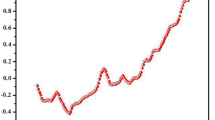Abstract
Acetone emission from pine plants (pinus sylvestris) is measured by continuously stirred tank reactor. Under a constant light intensity, acetone emission rates increase exponentially with leaf temperature. When leaf temperature is kept constant, acetone emission increases with light intensity. And acetone emission in darkness is also detected. Acetone emitted from pine is quickly labeled by 13C when the plants are exposed to air with 630 mg/m3 13CO2. However, no more than 20% of acetone is 13C labeled. Acetone emission from pine may be due to both leaf temperature-controlled process and light intensity-controlled process. Based on these understandings, an algorithm is used to describe the short term acetone emission rates from pine.
Similar content being viewed by others
References
Kesselmeier, J., Kuhn, U., Wolf, A. et al., Atmospheric volatile organic compounds (VOC) at a remote tropical forest site in central Amazonia, Atmospheric Environment, 2000, 34(24): 4063–4072.
Wennberg, P. O., Hanisco, T. F., Jaeglé, L. et al., Hydrogen radicals, nitrogen radicals, and the production of O3 in the upper troposphere, Science, 1998, 279: 49–53.
Singh, H. B., Kanakidou, M., Crutzen, P. J. et al., High concentrations and photochemical fate of oxygenated hydrocarbons in the global troposphere, Nature, 1995, 378: 50–54.
Slemr, J., Junkermann, W., Volz-Thomas, A., Temporal variations in formaldehyde, acetaldehyde and acetone and budget of formaldehyde at a rural site in southern Germany, Atmospheric Environment, 1996, 30(21): 3667–3676.
MacDonald, R. C., Fall, R., Acetone emission from conifer buds, Phytochemistry, 1993, 34(4): 991–994.
Singh, H. B., O’ara, D., Herlth, D. et al., Acetone in the atmosphere: Distribution, sources, and sinks, Journal of Geophysical Research, 1994, 99(D1): 1805–1819.
Schuh, G., Heiden, A. C., Hoffmann, T. et al., Emissions of volatile organic compounds from sunflower and beech, dependence on temperature and light intensity, Journal of Atmospheric Chemistry, 1997, 27: 291–318.
Guenther, A. B., Zimmerman, P. R., Harley, P. C. et al., Isoprene and monoterpene emission rate variability, model evaluation and sensitivity analysis, Journal of Geophysical Research, 1993, 98(D7): 12609–12671.
Tingey, D. T., Turner, D. P., Weber, J. A., Factor controlling the emissions of monoterpenes and other volatile organic compounds, in Trace Gas Emissions by Plants (eds. Sharkey, T. D., Holland, E. A., Mooney, H. A.), San Diego: Academic Press, 1991, 93–119.
Author information
Authors and Affiliations
Corresponding author
Rights and permissions
About this article
Cite this article
Shao, M., Wildt, J. Quantification of acetone emission from pine plants. Sc. China Ser. B-Chem. 45, 532–540 (2002). https://doi.org/10.1360/02yb9070
Received:
Issue Date:
DOI: https://doi.org/10.1360/02yb9070




